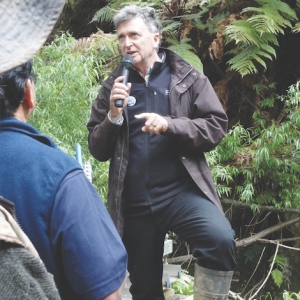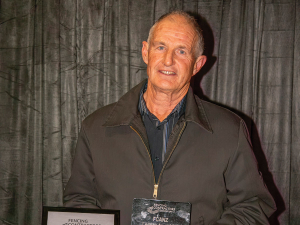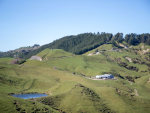However, a multi-stakeholder oversight group, consisting of farming, forestry, policy, science, Maori and conservation interests had been at work since 1996 creating an Integrated Catchment Management design. By 2000 they’d produced a plethora of visions, goals and performance indicators, assessing the current state and identifying priorities for progress.
Six over-arching goals were selected: to run a sustainable business, with healthy ecosystems, protecting landscape values, partnering with community and regulatory bodies, producing demonstrable environmental performance, and aiming for adequate rural infrastructure.
Subsequent research by NIWA, AgResearch, Beef + Lamb NZ, NZ Farm Forestry Association, Waikato Regional Council and the NZ Association of Resource Management, has produced around 75 papers covering the whole system, water quality, stream ecology, hydrology, pastoral system and terrestrial ecology.
In 2008 the land became part of the Treaty settlement with Tainui, and the forested land is now part of a joint venture between AgResearch and Tainui Development.
As the 100 or so visitors to last month’s one-off field day on the farm saw, environmental management work has been of good quality, but that’s come at a cost. Over 10 years an estimated $600,000 has been invested in tree planting and pruning, riparian fencing 10m wide strips, and replanting a 15ha of native remnant, all on land purportedly worth $740,000.
Stock policy has shifted to bull beef, bought in as weaners and sold at 18 months, and the sheep flock changed to a composite maintained with bought-in two-tooth replacements, with resultant increases in productivity (see table).
There has been an enormous amount of work done on water issues during the decade. Stream behaviour and width in what was open pasture has changed dramatically where pines, poplars, and natives now provide shade. Once narrow, with much silt residue at the banks, the shaded streams now have more consistent temperature, and are becoming wider and slower as trees take up water and banks become covered in vegetation.
There is still some E.coli present due mainly to pest animal life around the trees, but water is clear and little sediment moves apart from during storms.
In wooded areas understorey vegetation and saplings are reappearing on what was bare earth when stock had access.
Around a large waterfall at the bottom of the farm, aquatic life is also recovering, but only slowly. There’s talk of using mussel ropes or similar to help whitebait climb the streams. Twigs and fallen wood will eventually naturally foster stream life, providing the hiding and resting places fish, crayfish and longfin eels need to increase in number, but that will take decades by natural processes so installed tree-fern log barriers are being tested.
A challenge for such environmental renovation is the cost, given the low returns in farming such environments, a point acknowledged at the field day by Waikato regional councillor, Stu Kneebone.
“The cost of riparian fencing in these multi-streamed environments is something that local, and perhaps central government, will have to consider, as to who will pay and how it will be done,” he said.
Not all native species will thrive in any one environment, and choosing the right ones, and paying what can be a considerable cost per sapling, will also be difficult for individual farmers.
Farm forestry with pines may provide a clearer economic pathway, but even then there are substantial management costs to be financed during the 20 or so years’ growth and land used is often steep, making it difficult and expensive to harvest. Plans should include extraction methods and associated resource management consents for roading, as well as repayment of carbon credits.
“It may be more sensible and profitable, given carbon prices, to designate very steep country as permanent forest sinks, earning at least some carbon credits,” John Simmonds, WRC commented.
So, to summarise the field day: lots of research; lots of ideas; better farm productivity but no magic bullets for hill country farming just yet.









